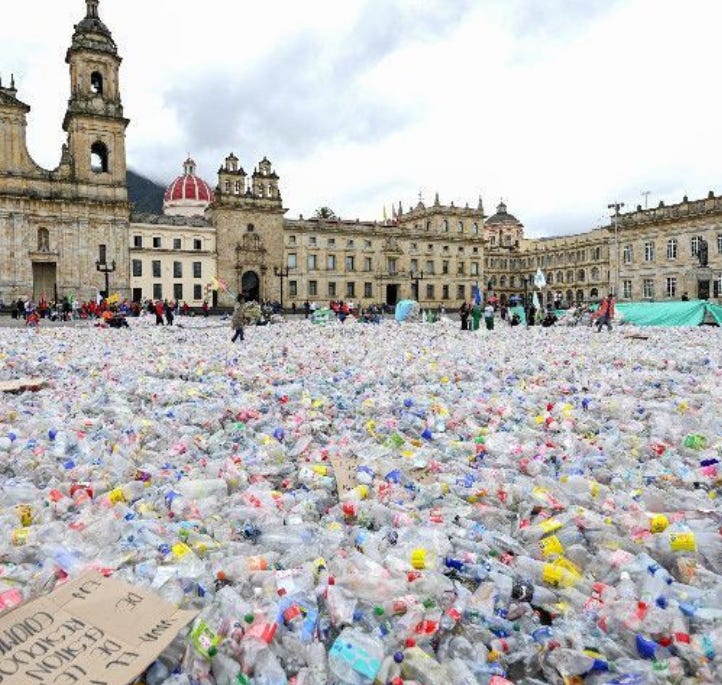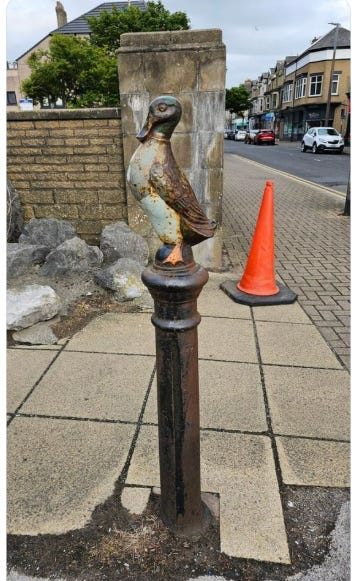Welcome to this week’s take on last week’s logistics in the news. Opening with a collection of variations on meme about the A-10 is both a connection to the issues of concern in the newsletter, and also a reminder that “communications” are information logistics. Memes are concentrated information delivered instantaneously. :)
Iran ‘Crisis’ (?)
We do not have a name for events including the US, Israel, and Iran, nor is it entirely clear whether the use of force by the US will continue, or what end is sought by the Administration, which has signaled almost all points across the policy spectrum. However, what became clear on Monday and throughout the week is that Iran topmost, and perhaps Trump as well, were interested to limit the event to the greatest extent possible, to include coordinating Iran’s response attack on US bases in the region.
The crisis reminds, as well, that the modern food system depends significantly upon the oil sector throughout the production and distribution chain.

New York Times had reporting on Tuesday of concern regarding infrastructure threats and risks and Trump Administration cuts. Recall from the last “Last Week” post:
And in infrastructure risk, critical networks across the US running water, power, transport, and other systems are at heightened alert for Iranian cyberattacks. Post-DOGE, it is worth asking whether the Federal Government retains the necessary capabilities and capacities necessary to defend the nation’s digital and other infrastructure. Furthermore, what law enforcement capacity in cyber has been seconded to the immigration crackdown? Have the President’s policies left gaps of vulnerability as yet unidentified?
Defense
Sweden adds new batteries to the air defense capacity supporting its maneuver brigades. The Dutch have contracted with Oshkosh Trucks for a new all-terrain expeditionary vehicles. Danish armed forces will continue to borrow heavy engineering equipment for training from Canada. Denmark inks deal to produce artillery rounds and other munitions.
In logistical organization, the Norwegian Army is creating a Technical Support Regiment to centralize responsibility for maintenance and supplies for other army units. “Corporal Frisk” offers analysis of the logistics and implications for Norway of Finland and Sweden’s new membership in NATO.
The NATO Summit disappointed some, but achieved the critical political aims to keep the US in, the Russians out, and Ukraine supplied were achieved.
USAF celebrates a perennial tradition to divest its arsenal of the last A-10s as part of the current budget request. Whether this is the dozenth time’s the charm moment and the aircraft is not spared at the last moment is unknown. But if it should go, it should absolutely be considered for transfer to Ukraine. Perhaps too brutish and vulnerable for American usage, the pure ferocity of the Warthog will appeal nonetheless to the Ukrainians.
Ukraine War
More details on the Spiderweb Operation against Russia. And Vasyl Malyuk, head of Ukrainian SBU, deepened the psychological impact of the operation during an interview in which he explained how they corrupted border agents to move supplies into Russia. This, on top of the suspicion sowed about the trucking and container fleets, will further expand the impact of the operation beyond its physical results. The broader, daily campaign against Russian industry and infrastructure continues.
Check out this Note on LoCs Warfare and Ukraine drone operations and let me know your appraisal.
In air defense, the Kyiv Post reported that “the UK to supply Ukraine with 350 ASRAAM air defence missiles, funded by frozen Russian assets. The missiles will be deployed via British Raven launchers, with five additional units en route — bringing the total to 13.” The Dutch are promising a new aid package, to include transport vehicles for casualty evacuation, and drones and investments in Ukrainian drone manufacture, all in addition to recent contracts signed. At the industry forum during the NATO summit Zelensky suggested Ukraine could reach 8 million units produced annually, in addition to other defense manufacture, with allied support. Germany will contribute to this potential with roughly Euro 100M pledged to finance production of the An-196 deep strike drone. Australia’s donated M-1 Abrams tanks are in Poland, and being readied for delivery.
The Bayraktar is returning to service. A favorite from early in the war, its exploits created a cultural phenomenon, with its own soundtrack.
I saw discussion that the vulnerability of transport (goods and personnel) to enemy drones on the administrative front lines is driving a push for logistics robots. In the tight calculations of this war, Ukraine might be able to gain an advantage, but long term utility cannot be assumed. If we look at the history of air-drops, gapping the human in the final leg of delivery is never as successful as hoped.
The Russian economy continues its decline as one in three companies “complained about the deterioration of its financial situation.” The public sector is suffering the financial constraints from the defense over-spend, with stagnating wages in the postal service leading to the closure of post offices in the Barshkortostan and Perm administrative regions. Even Putin admits it is a problem.
How does the complex attrition culminate? This review of William Philpott’s history of the strategy in WWI offers an exceptional view to the operation of factors that combine and lead to collapse.
Maritime
On the Russian sub-rosa takeover of Yamal LNG shipping fleet for possible covert operations in Europe. I am uncertain what fully to make of this reporting, but I will leave it here for your consideration.
The Morning Midas, a car carrier ablaze since 3 June, sank in the Pacific Ocean - the fire was located on the deck housing electric vehicles. As electrification expands, the risk profile for the transport of EVs and batteries will become an issue, with additional insurance and segregated carriage as likely responses, increasing costs. We are making the mass mistake that the Industrial Revolution enabled, and will see similar negative effects compounding in the coming years if we do not rethink certain consumption assumptions.
Common interests in Pacific maritime security issues were addressed in dialogue among experts representing the trilateral partnership of Australia, India, and Indonesia.
Trade and the Economy
The US
As US consumer spending exports dropped 5.2% in May, more layoffs and delayed capital investments in the US auto parts industry as tariff uncertainty dims future prospects.
The machines that build the pieces, the supply chain of the supply chain: ASML will increase production of advanced chipmaking machines. This is why it is important to think of supply systems, rather than a coherent chain - each node in one system is an entire system elsewhere.
Sarah Taber has thoughts on Farms and the Budget - the news is bad. Food Security and the Virgin Islands is at issue, discussed here.
Samuel Pepys reminds us from the 17th century of the importance of standards and regulations in food production: “Took Commissioner Pett home to dinner with me, where my stomach was turned when my sturgeon came to table, upon which I saw very many little worms creeping, which I suppose was through the staleness of the pickle.”
Eurasia
Turkey is re-asserting its geo-importance with a new road infrastructure development plan.
Infrastructure
China suffered severe flooding last week, causing massive evacuations and infrastructure damage, to include this harrowing bridge collapse.
Video captured the moment a roadway in St. Louis buckled under the strain of the heat. This is just the tip of the iceberg of costs associated with climate change, with the US expenditure clocked at $1 trillion annually. Or, if you prefer, less than the cost of mitigation strategies. The current budget under negotiation will both exacerbate those costs with losses to forecasting and accelerated climate change-inducing practices and enterprises, while also making uncertain whether, who, and how these costs will be addressed.
North Carolina’s legislature voted unanimously to ban parking minimums in new developments across the state. Why that matters, here. Where parking infrastructure is extant, it can be redeveloped, as in this strip-mall parking lot reconceived into affordable housing. Eliminating gross paving coverage has to help with the climate crisis and excess rainfall. But I’ve never seen research on the topic. If you know of any research on permeability, runoff, and flooding, I would be very interested.

Transport and Transit
An explainer on how to get a job in transit!
“Why driving is bad for business, household wealth, and community prosperity”. Individual car ownership may be a visible marker of personal wealth, but the data suggests that car dependency is a drag on the economy.
China’s trucking fleet is increasingly electric - while I am EV skeptical for the personal vehicle market (that is, such a market at global scale will always be environmentally and climatically problematic), but for commercial and transit, they will be very important.
Old trains, new lives. Decommissioned rail cars from Canada are running anew on lines in South America. Dutch rail failures: “A power outage early on Tuesday has disrupted some traffic to and from the Netherlands' main airport Schiphol, located 50 kilometers from where leaders of the Western defense alliance NATO are gathering today and tomorrow.” Authorities were investigating the cause. Rail Baltica, a new line connecting the Latvia, Lithuania, and Estonia, will also advance military mobility for NATO and the frontier states.
SwissAir innovates in packing with new containers for their cargo service.
Closing with a mystery, this thread on the crash of Itavia flight IH870 from Bologna to Palermo on 27 June 1980 is fantastic!






